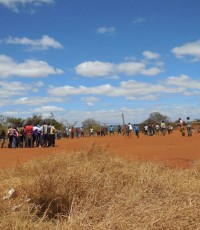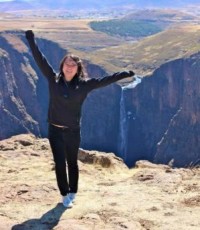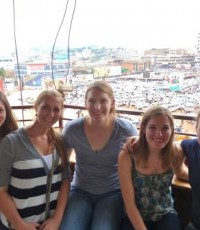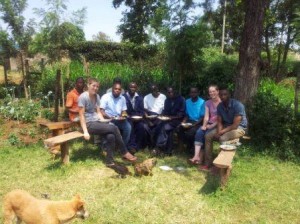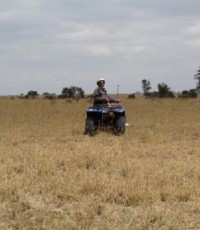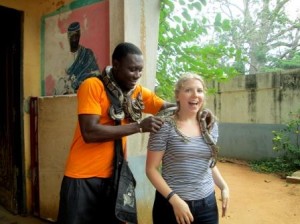September/October 2013
Only a few months have passed since our 2013-14 Fellows began arriving in Africa, but we are already amazed at their accomplishments across the continent. A few examples include:
+ Designing plans to bring sinks into schools, together with teachers and administrators in Kenya.
+ Becoming the focal point for a new gender initiative underway in Malawi.
+ Organizing a service learning trip for students to a refugee camp in Botswana.
+ Even a 4.5km open water swim from Dakar to Gorée island! (Our Fellows have fun too…)
The September/October 2013 issue of the Princeton in Africa Fellows’ Flyer includes even more great examples of what bright, passionate young adults can do when given the chance to spend a year of service in Africa – enjoy the stories below from our 2013-14 Fellows in Kenya, Uganda, Benin, Lesotho and Botswana.
All of the staff and board at Princeton in Africa feel honored to be able to make these life-changing fellowship opportunities possible – and, in our own small way, to help our partner organizations achieve more on the ground in the African communities they serve. Thank you to all of you who support our work and contribute to this amazing effort too!
Warm regards from Princeton,
Katie Henneman
Executive Director
P.S. We are now accepting applications for 2014-15 fellowships! Graduating seniors and young alumni from any accredited U.S. college or university are eligible to apply. For more information, check out our website at www.princetoninafrica.org or email piafapp@princetoninafrica.org. Applications are due Wednesday, November 6th, 2013 at 11:59 p.m. EST!
PiAf Connections
Please click below to check out pictures of our Fellows, Alums and other members of the PiAf family meeting up at home and around Africa.
Notes from the Field
By Phoebe Carver, 2013-2014 Fellow with Maru-A-Pula in Botswana
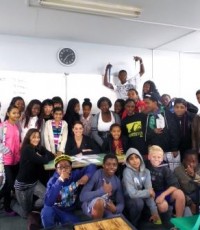
Ms. Carver (second row, center) with her Form 1 History class on “civvies” day”. (Civvies are when the students can wear casual clothes!).
Today marks my 60th day living and teaching as a Princeton in Africa Fellow at Maru-a-Pula School, an incredibly vibrant institution in Gaborone, Botswana. In some ways, it feels like I just arrived, as I scramble to understand how the finals schedule works and what “invigilating” exams entails. On the other hand, as I expertly set off to take down my homeroom “form class” register, hand it in at the front office, and hurry off to the H1 classroom to invigilate, I realize that I have begun to feel the pulse of the school where, luckily for me, I will be working and living for the next year of my life.
Admittedly, as I considered the possibilities for where I would land after graduation, teaching history to thirteen-year-olds did not cross my mind as a remote possibility. Fast forward to four weeks after graduation, and there I was, standing, jet-lagged and over-stimulated, in front of 29 smiling faces, introducing myself as “Ms. Carver.” Despite my exhaustion, I found myself feeding off their exuberant energy as they peppered me with questions. Maru-a-Pula students, I quickly learned, are as locally renowned for their self-assurance as they are for their academic prowess.
In my first several weeks at Maru-a-Pula, I anxiously learned material, questioned my colleagues and planned my lessons. As time went on, my anxiety dissipated into a focused energy, and I found myself enjoying the routine of teaching, despite the painful transition from 10 AM college classes to 6:55 AM morning staff briefings. As I regaled my parents with stories from my classes over emails and forced my co-PiAf fellows Fritz Siegert and Riley Brigham to listen to my students’ often insightful, occasionally hilarious responses on tests and projects, I began to realize that teaching might be it, after all.
My pinnacle moment in my first term as a teacher at MAP took place during one of the less-glamorous aspects of working at a boarding school: Saturday night dorm duty. As I peeked into each of the girls’ rooms for 11 PM check-in, one of my shyest students tentatively asked me a burning question about colonialism. As I focused my energy on answering her diplomatically, thoroughly, and in a way that she could understand, I felt a rush of joy and satisfaction that my attempt to make history engaging was, at least for one student, working.
In what other job could I spend creating activities that, the very next day, I can put into action? In what other environment would I be forced to almost instantaneously learn 61 personalities, and try to harness those personal dynamics in order to foster a productive classroom environment? In what other setting would I feel that rare magic when a lesson goes right, and I hear students discussing the lesson during break? I feel humbled and honored to have become a small piece of the Maru-a-Pula puzzle, and, for me, these first 60 days as “Ms. Carver” have been a fabulous roller-coaster of learning from the faculty, and, most importantly, from my students.
Notes from the Field
By Kristen Conroy, 2013-2014 Fellow with Nyumbani Village in Kenya
As the tour guide for visitors here at Nyumbani Village, an alternative orphanage for orphans and grandparents affected by HIV/AIDs, I can’t think of a better way to introduce you to the Village than by giving you a tour with a personal twist. Let us begin…
Sustainability Office: Where I work and where one can buy items from honey to moringa to papaya seedlings to chickens and more!
Homecare Department: Where I experience home visits; the process by which Social Workers visit potential orphans to fill vacancies in the Village and assess their level of need.
Reception Office: Where I meet with the Program Manager to discuss budgets, Standard Operating Procedures, and natural resource management.
Accounting Office: Where I file requisitions to maintain all rainwater tanks and gutters before the rainy season.
The Clinic: A convenient clinic for all basic ailments.
Lawson High School: Here, I begin leading a Girl’s Club this week. A student here with a keen interest in computer programming first taught me to make chapatti.
Hotcourses Primary School: Where I attend Swahili classes after the 700 students, all children living in the Village, go home.
Nyumbani Youth Polytechnic: Where we are piloting a sink building program, using materials made by the students, to try to improve hygiene in the Village.
The Stores: Where I collect blankets for large groups volunteering in the Village.
Social Hall: Where I attended a whole village meeting of grandparents and children, completely in KiKamba.
Canteen: Where I purchase amazing chapatti, avocados, and buy flour and cooking fat for the mandazi and chapatti lessons I have with the children.
Clusters: The true gem of the Village. This is where all the families live in “clusters” or groups of four houses. Each house has 10 children and 1 grandparent. Here is where I come after work to play jump rope or jumping games, to have my hair done (having the only real, long hair in a Village makes it quite a hot commodity to play with), drink tea, have my name shouted by hundreds of children, be given Kiswahili vocabulary lists and quizzes, read books, talk about our days, embrace the innate joy within the children, and genuinely be made grateful and content every evening.
Greenhouse/ Propagation Unit/ Farms: Where Sustainability grows numerous plants and trees in an attempt to eventually fully feed and economically support the village.
Trees for Children: The underpinning of Nyumbani’s sustainability program. Trees for children offers the potential for Nyumbani to be self sustaining in the future by planting 50 acres of melia trees each year.
Livestock: Where I brought a group of high school senior volunteers from a private school in Nairobi to sweep cow dung and stack hay. Also where I get information on composting and biogas digestion and where milk for the villagers is produced.
Beyond Trees for Children: Where I was taught, by patient teachers, to collect, bundle, and carry firewood.
All of this in a Village of 1000 acres and 1000 children.
Notes from the Field
By Lillian Jin, 2013-2014 Fellow with Baylor International Pediatrics AIDS Initiative in Lesotho
Every morning, the staff of Baylor’s clinic gathers for morning prayer in the clinic waiting room. Patients and doctors sing traditional Basotho hymns together and share announcements before starting business at the clinic. Any staff member that wants to lead prayers will start singing a song of their choice, and everyone will follow suit, ending with a brief prayer. The usual babbling of babies is quieted, and for a few moments every morning, the clinic is transformed into a space of calm and reflection. Then, spontaneously and seamlessly, the clinic will return to business as usual with doctors calling for patients and social workers sidestepping children on their way to various meetings.
Everyday, I dress in Western business clothes for work, where I enjoy an office with cushy new rolling chairs and wireless Internet. After work, I grocery shop at the giant Shoprite in the second new mall of Maseru and take spinning classes at the massive gym complex in town. Lots of foreign investment is moving into Lesotho, and the newfound wealth is becoming apparent in town. Some restaurants in Maseru could be mistaken for restaurants in Manhattan. European sports cars share the road with crowded public taxis.
An hour’s drive outside Maseru, cars are replaced by herd boys on donkeys, and the cinderblock houses of town change into rondevals and farmland. The influx of immigrants and investment in Lesotho has grown within the country’s agrarian traditions, changing but not resolving the experience of poverty for most in Lesotho. The new public hospital next to Baylor’s clinic has almost all the equipment of an American hospital, but children die from taking traditional medicine, usually a combination of lighter fluid and other chemicals, every month. My Basotho friends will shop for shoes on American websites, while planning their itinerary of funerals on Saturday, the designated funeral day of every week. In my short time here, I’ve seen how negotiating between the new and old is a constant part of living and working in Lesotho.
Baylor’s clinic looks like any doctor’s office in the US, but morning prayer is a tradition that could not be found in the secular industry of American health care. Lesotho’s government only started providing free ARVs in 2004, and with one in four people infected, treatment strategy has only recently been able to ease out of emergency intervention and start prevention initiatives. Many patients are friends or relatives of the clinic staff, and in the small world of Maseru, everyone seems to know everyone else. Certainly, everyone has lost someone to AIDS. By including the patients in the announcements and blessings of the staff, morning prayer honors an ethic of community that is so important to life in Lesotho. Morning prayer is one of my favorite parts of being in Lesotho because it is a daily reminder of the human relationships necessary to treat an epidemic in a country in flux.
Notes from the Field
By Kelly Lacob, 2013-2014 Fellow with Clinton Health Access Initiative in Uganda
How to describe my first month in Uganda working for Clinton Health Access Initiative, where getting sick with malaria is an encouraged component of the onboarding process, where my coworkers and their accents represent more than 10 countries, and no matter what you order for lunch from the roadside stand near the office, you’re bound to end up with more or less the same thing: a heaping bowl of rice, beans, and groundnut paste (but hey, it only costs 2,300 Ugandan shillings, less than $1, so who’s really complaining?)?
I would have to describe it as tough, confusing, surprising, and exhilarating. I work on private sector analysis for the essential child medicines team, and the learning curve is undeniably steep, but I have seldom felt more fulfilled. As I prepare a strategy document for incorporating IV artesunate into the supply chain for severe malaria treatment, or perform statistical analyses on retailer markups of oral rehydration salts and zinc for pediatric diarrheal disease (with the hope of persuading the Ministry of Health, the National Drug Authority, and drug suppliers of the need for a regulated ceiling price), I know that the work I am doing matters. Not every day is glamorous and exciting, many aren’t; but I’m able to recognize that even the countless hours I sometimes spend reviewing literature and scouring the web for esoteric facts are part of a greater mission. I also know that I’ll appreciate this strong foundation when I start performing field visits in the next couple months to validate and expand my research—a prospect I’m looking forward to with great anticipation.
And what about life in Uganda more generally? The same descriptive words suffice. So far I’ve managed to blow up my hairdryer when I forgot to use a voltage adaptor one day, ruined a load of light-colored clothes in my first attempt to do laundry by hand, and wasted 40 minutes and 20,000 shillings trying ineffectually, fruitlessly to direct a driver back to my guesthouse at night, when all the roads I’d toiled to learn suddenly became unrecognizable in the dark. However, I’ve also successfully haggled for a bedframe, end table, and standing shelf for my new apartment, discovered that I actually like matoke and goat meat, and bought my first piece of local art—a beautiful fig bark painting of a woman taking produce to market, which I plan to hang in my new kitchen. I work long hours and often take my work home with me on weekends, so I haven’t had the opportunity to travel outside the city yet, but I’m enjoying getting to know the local restaurants, learning about the history of the Buganda kingdom through visits to the Kabaka palace and Kasubi tombs, and forming meaningful relationships with my Ugandan coworkers over drinks and meals with their families.
There are rewarding days and frustrating days, but every day is one of growth, and for that I am grateful. It is exactly what I wanted from this experience.
Notes from the Field
By Emily Moder, 2013-2014 Fellow with access:energy in Kenya
Currently, Kenyans in remote areas pay a small fortune for access to electrical power. Wind-and-solar micro-grids provide a promising solution, but these installations sometimes struggle because they are hard to monitor, and many of the beneficiaries don’t have bank accounts to pay for their energy. I now work at access:energy, a small start-up that develops renewable micro-grid technology to help combat these kinds of challenges, and open the markets for renewable energy micro-grids in the developing world. Two months after I arrived in Kisumu, the hub of western Kenya’s Nyanza province, we relocated to Nairobi. Here is a sample day-in-the-life comparing my two African homes:
KISUMU
7:00am: Wake up, make oatmeal and tea for breakfast
7:45am: Walk to the matatu stage (the stop for 14-seat vans that will take me to work). Wait for the matatu to fill up with people; we will not leave until at least 20 people are inside
8:30am: Arrive at the workshop in Kiboswa village; greet everyone in their preferred language – Luo, Swahili, or English
8:30am-1:30pm: Develop software–management systems to help us keep track of our inventory and purchases; try to tune out the sounds of chainsaws, welding torches, and farm animals next door
1:30pm: Lunch: ugali, beans and rice…always. Feed the chickens our extra rice and have contests to see who can catch them in the most creative way
5:30pm: Take a matatu back to town. On the walk home, buy fruits, veggies, and eggs from the vendors on the side of the road
7:30pm: Meet friends for Kenyan trivia night and nyama choma (Kenyan barbeque) at the local mzungu hangout
9:30pm: Take a tuk-tuk or a hickey-pickey (motortaxi or motorbike) home; chat with people back home and go to sleep
NAIROBI
7:00am: Wake up, make oatmeal and tea for breakfast
7:45am: Walk to the bus stop, leave promptly for the office; the number of people is never greater than the number of seats
8:30am: Arrive at our office building and take the elevator to the 4th floor; greet everyone in Swahili
8:30am-1:30pm: Develop software – smart micro-grid design programs and systems to enable energy payments via mobile phone; stay motivated listening to Pandora on our lightning-fast internet
1:30pm: Lunch: beef curry, samosas, Rolex (an egg rolled in a chapati) – the possibilities are endless. Unless the microwave is broken.
5:30pm: Walk home, stopping by Nakumatt, the Kenyan equivalent of Wal-Mart, for groceries (they even have cheddar cheese!)
7:30pm: Meet friends at Habesha, a favorite Ethiopian restaurant; discuss travel plans, and favorite matatu bumper stickers
9:30pm: Take a taxi home; chat with people back home and go to sleep
Notes from the Field
By Krishnan Raghavan, 2013-2014 Fellow with International Rescue Committee (Somalia) in Kenya
This piece was written before the tragic attack at the Westgate mall in Nairobi. We are grateful that all of our Nairobi-based Fellows are safe, and our thoughts are with the Nairobi community at this difficult time.
When I found out I would be working for the International Rescue Committee’s Somalia office in Nairobi, I was elated. I couldn’t wait to leave civilization behind and embark on a fruitful journey of self-actualization in Africa. Little did I realize how difficult finding myself would be in a place where nothing turns out the way you expected it would. Three months later, I’m no closer to self-realization and who’s to blame? I’ll tell you. Instead of the introspection and personal epiphanies you might have expected, here are the top 5 things I hate about Nairobi.
Cultural attractions – When I first discovered I’d be moving to one of the most crime-plagued cities in Africa, I was thrilled to finally have the excuse I’d been looking for to stay in 24/7. “No, I can’t come to your DJ night because I’ll be carjacked” sounded a lot more sympathetic than “Actually, I’d rather be wearing pajamas and streaming Netflix with my hand in a box of ranch-flavored Wheat Thins.” Much to my displeasure, however, there is simply too much to do in and around Nairobi to avoid going out. I’ve had to sit through amazing pan-African music festivals, endured some absolutely thrilling hunts for lions, leopards, giraffes, and zebras on Jeep and ATV safaris, and been forced to eat excellent food from all around the world at Nairobi’s top-notch restaurants. Is it too much to ask for a little me time?
Brunch – Nothing is more stressful than waking up on Sunday morning and deciding where to go for brunch. Would I rather be eating goat cheese quiche at Dorman’s, or a Spanish omelet at Artcaffe? Am I even sure whether I want to go savory or will the thought of orange yogurt muffins at Java House tempt me to go sweet? It’s exactly this kind of dilemma I’d hoped to avoid by moving to Kenya, and the emotional toll it’s taking on a weekly basis leaves me far too fragile to have any kind of personal insight.
My apartment – Living in the office guesthouse a three-minute walk from work could not be more grueling. For starters, I will never be able to live on my own again thanks to the office’s delightful housekeeper, who comes to the guesthouse five days a week to do the cleaning, dishes, and laundry. Having virtually no commute means I now have vast swathes of free time I’m forced to fill with morning runs, after-work yoga classes, and soon even Swahili lessons. Discovering that our apartment came equipped with communal pool and flat-screen TV with 500 channels dashed any last hope I had of attaining enlightenment through living simply. Woe is truly me.
Kenyans – Like any good expat, I had hoped the local population would serve as wonderful character foils to my personal narrative of self-discovery abroad, perhaps appearing occasionally in my narrative to dispense pearls of wisdom or as part of comical lost-in-translation moments I could recount charmingly at cocktail parties. You can therefore imagine my frustration at how incredibly easy it has been to form close friendships with Kenyans in the office and socially, given that these friendships are based on our mutual understanding and appreciation of one another rather than revolving completely around me. Unbelievable.
This whole city and country – For helping me to realize only one thing about myself: I never want to leave.
Notes from the Field
By Sarah Sagan, 2013-2014 Fellow with World Food Programme in Benin
I am often reminded of how fortunate and grateful I am to be spending a year in Cotonou, Benin, as a Princeton in Africa Fellow. Whether it is the ability to continue my current five pineapple per week diet (sold for 20 cents outside my home) or quietly celebrating a successful negotiation for a zémidjan (moto-taxi) ride throughout town, I continue to find new moments of independence, adventure and learning.
Arriving in Cotonou over two months ago, I remember feeling calm on the plane ride. Perhaps lack of sleep dulled my nerves, but it wasn’t until I disembarked that a quick wave of anxiety hit–I will be living in Benin for a year, working for a new organization and speaking a language that I had not studied since a Louis XIV literature course in December 2011. Thankfully, the onset of nerves dissipated as quickly as they hit. My roommates were waiting at the airport, eager to welcome me. My coworkers were generous with their time, happy to orient me to the new environment. And even my French skills improved when I decided early on that I would refuse to be embarrassed by my grammatical errors and openly ask for advice. (Night one: “J’ai besoin d’aide avec mon grammaire.” My roommate: “Uh, ‘ma grammaire.’”)
Serving as a Pipeline and Reports Officer with the World Food Programme continues to be a rewarding part of my fellowship experience. The project undertaken by the Benin WFP office is “Promotion of Sustainable School Feeding,” a model of providing nutritious meals to elementary school children that, to summarize, aims to encourage local agricultural capacity and to increase enrollment and attendance rates. With the Benin school year not in session, I have been working on my monthly reporting responsibilities, writing and editing a grant proposal, and helping prepare for the feeding programme once the school year begins. I look forward to visiting our beneficiaries and learning more about the on-site operations of WFP.
Despite my natural inclination for to-do lists and plans, what I continue to value most of all are the moments of spontaneity that come with exploration and travel. Living in Cotonou has reminded me of the value of a less-scheduled life. I often spend weekends here trying to become a better baker, lounging at the beach and hanging out with my newfound community. I value the time to reflect and have unexpected experiences. Therefore, in Benin, when your tour guide decides last minute to take you to a family funeral and then a voodoo ceremony, you smile because you know that in the end, the story and the experience are worth far more than any initial hesitation about straying from the plan.








